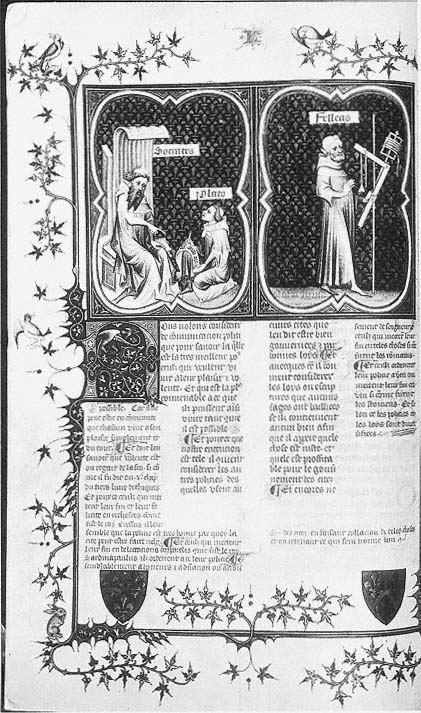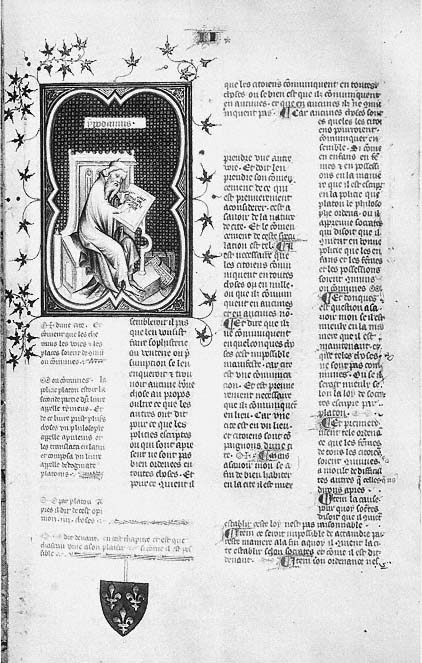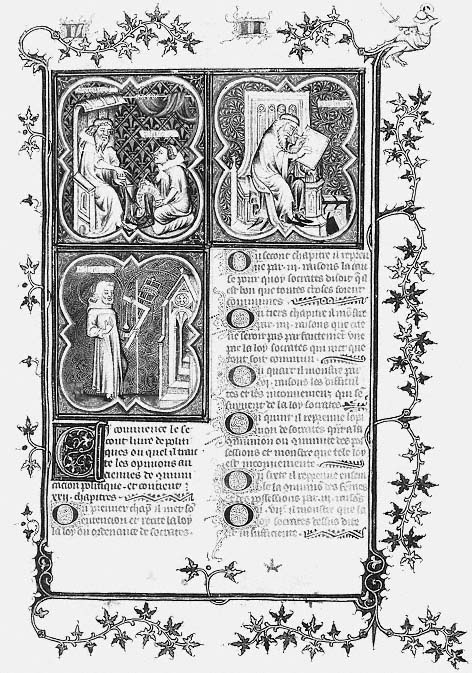The Designs of the Miniatures
In B the cryptic and conservative representational mode of the illustration contrasts with the lavish layout of the two folios on which the three portraits are

Figure 55
From left : Socrates Dictates to Plato, Phaleas. Les politiques d'Aristote, MS B.

Figure 56
Hippodamus. Les politiques d'Aristote, MS B.

Figure 57
Top, from left : Socrates Dictates to Plato, Hippodamus; bottom : Phaleas. Les politiques
d'Aristote, MS D.
placed (Figs. 55 and 56). Executed by the artist known as the Master of the Coronation of Charles VI, folios 32v and 33 are the most lavish in this deluxe manuscript. For the first time the arms of Charles V (azure shields bearing three fleur-de-lis) appear twice on the lower margin of folio 32v and once on folio 33. Fleur-de-lis also appear as the overall geometric motif in the backgrounds of the miniatures of folio 32v. The decoration of this folio is exceptionally enhanced by the appearance of a rabbit and three birds among the ivy-leaf sprays of the upper and side borders.
All three miniatures are isolated by gold outer and tricolor interior quadrilobe frames. A continuous relationship between the two folios is assured not only by repetition of the shield but also by the alignment and color symmetry of the third miniature on folio 33. A blue-red-blue color scheme unites the layout. Placed after the chapter headings and above the introductory paragraph of Book II, Figures 55 and 56 are distinguished by their large size. The grisaille modeling of the figures, associated in the B cycle with this illuminator, increases their monumentality. The mannered elegance of the master's style, evident in the figures' drapery, hands, and feet, is echoed by the elongated proportions of the quadrilobes. Yet intensity of gesture and expression coexists with the somewhat archaic style. Compatible with the overall design of the folios, both figures and frames contribute to an antinaturalistic effect characteristic of the three miniatures in B executed by this master.
In contrast to the lavish layout of Figures 55 and 56, the illustration for Book II in D (Fig. 57) is more modest. Consistent with the re-editing of this manuscript, the three miniatures have been compressed into a two-register format on a single folio. The first and third exceed the width of the first column of text with which they are aligned. Each miniature is about half the size of its counterpart in B . A member of the workshop of the Master of the Coronation Book of Charles V followed the design of the miniatures of B in the interior quadrilobe frames and the color scheme of the background. The grisaille modeling of the figures in D is a feature characteristic of the entire cycle. As is usually the case in these two manuscripts, the miniatures appear below the running title identifying the book and above the chapter headings and summary paragraph. This order helps the reader to connect the image and its inscriptions with specific information about the contents of the individual book. For example, the general relationship of the images to text occurs in the introductory paragraph: "Cy commence le secont livre de politiques ou quel il traite les opinions anciennes de communication politique et contient .xxii. chapitres" (Here begins the second book of the Politics in which he discusses the ancient theories of political organizations; [it] contains twenty-two chapters).[2] Figures 55 and 56 also provide a linkage between the chapter heading and inscription of each miniature. Thus, Socrates' name occurs in the titles for Chapters 1 to 5 and 7 to 9; Phaleas's in Chapters 11 to 12; and Hippodamus's in Chapters 13 to 14. The normal order of reading the miniatures from upper left to upper right is, however, not observed in Figure 57. Here, the process of consolidating the miniatures on one folio has resulted in an irregular presentation of sequence in the text, where Phaleas is the second, not the last, of the three
thinkers discussed. It is possible, though, that the unusual feature of reading each element of the two-register format as an isolated entity allows a vertical ordering of the miniatures.